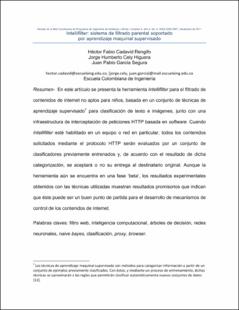Mostrar el registro sencillo del ítem
Intellifilter: sistema de filtrado parental soportado por aprendizaje maquinal supervisado
| dc.contributor.author | Cadavid Rengifo, Héctor Fabio | |
| dc.contributor.author | Cely Higuera, Jorge Humberto | |
| dc.contributor.author | García Segura, Juan Pablo | |
| dc.date.accessioned | 2021-12-03T16:03:34Z | |
| dc.date.available | 2021-12-03T16:03:34Z | |
| dc.date.issued | 2011 | |
| dc.identifier.issn | 22562567 | |
| dc.identifier.uri | https://repositorio.escuelaing.edu.co/handle/001/1888 | |
| dc.description.abstract | En este artículo se presenta la herramienta Intellifilter para el filtrado de contenidos de internet no aptos para niños, basada en un conjunto de técnicas de aprendizaje supervisado1 para clasificación de texto e imágenes, junto con una infraestructura de interceptación de peticiones HTTP basada en software. Cuando Intellifilter esté habilitado en un equipo o red en particular, todos los contenidos solicitados mediante el protocolo HTTP serán evaluados por un conjunto de clasificadores previamente entrenados y, de acuerdo con el resultado de dicha categorización, se aceptará o no su entrega al destinatario original. Aunque la herramienta aún se encuentra en una fase ‘beta’, los resultados experimentales obtenidos con las técnicas utilizadas muestran resultados promisorios que indican que éste puede ser un buen punto de partida para el desarrollo de mecanismos de control de los contenidos de internet. | eng |
| dc.description.abstract | This article presents the Intellifilter tool for filtering Internet content not suitable for children, based on a set of supervised learning techniques1 for text and image classification, together with a software-based HTTP request interception infrastructure. When Intellifilter is enabled on a particular computer or network, all content requested via the HTTP protocol will be evaluated by a set of previously trained classifiers and, based on the result of said categorization, its delivery to the original recipient will be accepted or not. Although the tool is still in a 'beta' phase, the experimental results obtained with the techniques used show promising results that indicate that this may be a good starting point for the development of Internet content control mechanisms. | ENG |
| dc.format.extent | 12 páginas. | spa |
| dc.format.mimetype | application/pdf | spa |
| dc.language.iso | spa | spa |
| dc.publisher | REDIS | spa |
| dc.title | Intellifilter: sistema de filtrado parental soportado por aprendizaje maquinal supervisado | spa |
| dc.type | Artículo de revista | spa |
| dc.type.version | info:eu-repo/semantics/publishedVersion | spa |
| oaire.accessrights | http://purl.org/coar/access_right/c_14cb | spa |
| oaire.version | http://purl.org/coar/version/c_970fb48d4fbd8a85 | spa |
| dc.contributor.researchgroup | Informática | spa |
| dc.publisher.place | Colombia | spa |
| dc.relation.citationissue | 4 | spa |
| dc.relation.citationvolume | 4 | spa |
| dc.relation.indexed | N/A | spa |
| dc.relation.ispartofjournal | Revista de la Red Colombiana de Programas de Ingeniería de Sistemas y Afines | spa |
| dc.relation.references | Adams, R. and Bischof, L. (1994). Seeded region growing. Pattern analysis and machine intelligence. IEEE Transactions on, 16(6), pp. 641-647. | spa |
| dc.relation.references | Akbas, E. (2008, October). Next generation filtering: oine filtering enhanced proxy architecture for web content filtering. pp. 1-4. | spa |
| dc.relation.references | Cline, V.B. (1990). Pornography's effects on adults and children. New York: Morality in Media, 11. | spa |
| dc.relation.references | Deselaers, T., Pimenidis, L. and Ney, H. (2008, December). Bag-of-visualwords models for adult image classification and filtering. pp. 1 -4. | spa |
| dc.relation.references | Youngsoo, K. and Taekyong, N. (2006, February). An efficient text filter for adult web documents. 1, p. 3. | spa |
| dc.relation.references | Kotsiantis, S.B. (2007). Supervised machine learning: a review of classification techniques. Informática, 31(3), pp. 249-268. | spa |
| dc.relation.references | Eberstadt, M. and Layden, M.A. (2010). The social costs of pornography: a statement of findings and recommendations. (1st. ed.). The Witherspoon Institute. | spa |
| dc.relation.references | Xuanjing, Shen, Wei Wei, Quingji Qian. (2997). The filtering of internet images based on detecting erotogenic part. In ICNC '07: Proceedings of the Third International Conference on Natural Computation, pages 732-736. Washington, D.C., USA. IEEE Computer Society. | spa |
| dc.relation.references | Varadharajan, V. (2010, July). Internet filtering issues and challenges. Security Privacy, IEEE, 8(4), pp. 62-65. | spa |
| dc.relation.references | Yi-Ding, W. and Jing-Nan, G. (2009, July). A method of erotic images filtering in real internet, 3, pp. 1477-1481. | spa |
| dc.relation.references | Qing-Fang, Z. and Wei Zeng, G.W. (2004). Shape-basedadult image detection. In ICIG '04: Proceedings of the Third International Conference on Image and Graphics, pp. 150-153. Washington, D.C., USA. IEEE Computer Society. | spa |
| dc.relation.references | The free dictionary. URL: http://encyclopedia2.thefreedictionary.com/Internet+proxy. | spa |
| dc.relation.references | Alpaydin, E. (2004). Introduction to machine learning. MIT Press. | spa |
| dc.relation.references | Sitio web de Ensing Solutions, consultor en IT y proveedor de NetNanny, URL: http://contentprotect.co.uk/dca.html. | spa |
| dc.relation.references | Sitio web de CyberPatrol. URL: http://www.cyberpatrol.com/research/sitecat.asp. | spa |
| dc.rights.accessrights | info:eu-repo/semantics/closedAccess | spa |
| dc.subject.armarc | Web filter | ENG |
| dc.subject.armarc | Computational intelligence | ENG |
| dc.subject.armarc | Decision trees | ENG |
| dc.subject.armarc | Neural networks | ENG |
| dc.subject.armarc | Intellifilter | ENG |
| dc.subject.proposal | filtro web | spa |
| dc.subject.proposal | inteligencia computacional | spa |
| dc.subject.proposal | árboles de decisión | spa |
| dc.subject.proposal | redes neuronales | spa |
| dc.subject.proposal | naive bayes | spa |
| dc.subject.proposal | clasificación | spa |
| dc.subject.proposal | proxy | spa |
| dc.subject.proposal | browser | spa |
| dc.type.coar | http://purl.org/coar/resource_type/c_6501 | spa |
| dc.type.content | Text | spa |
| dc.type.driver | info:eu-repo/semantics/article | spa |
| dc.type.redcol | http://purl.org/redcol/resource_type/ART | spa |
Ficheros en el ítem
Este ítem aparece en la(s) siguiente(s) colección(ones)
-
AD - CTG – Informática [76]
Clasificación B- Convocatoria 2018










